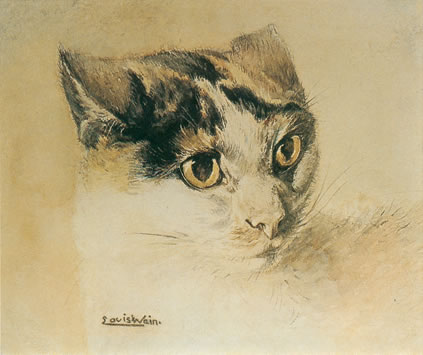Louis Wain (5 August 1860 – July 4, 1939) was an English artist best known for his drawings, which consistently featured anthropomorphised large-eyed cats and kittens. In his later years he suffered from schizophrenia, which, according to some psychologists, can be seen in his works.
Louis William Wain was born on August 5, 1860 in Clerkenwell in London. His father was a textile trader and embroiderer, his mother was French. He was the first of six children, and the only male child. None of his five sisters ever married. At the age of thirty, his youngest sister was certified as insane, and admitted to an asylum. The remaining sisters lived with their mother for the duration of their lifetimes, as did Louis for the majority of his life.
In 1886, Wain's first drawing of anthropomorphised cats was published in the Christmas issue of the Illustrated London News, titled A Kittens' Christmas Party. The illustration depicted 150 cats, many of which resemble Peter, sending invitations, holding a ball, playing games, and making speeches over eleven panels. Still, the cats remain on all fours, unclothed, and without the variety of human-like expression that would characterize Wain's work. Under the pseudonym George Henri Thompson, he illustrated numerous books for children by Clifton Bingham published by Ernest Nister.
In subsequent years, Wain's cats began to walk upright, smile broadly and use other exaggerated facial expressions, and wear sophisticated contemporary clothing. Wain's illustrations showed cats playing musical instruments, serving tea, playing cards, fishing, smoking, and enjoying a night at the opera. Such anthropomorphic portrayals of animals were very popular in Victorian England, and were often found in prints, on greeting cards and in satirical illustrations such as those of John Tenniel.

From this point, Wain's popularity began to decline. He returned from New York broke, and his mother had died of Spanish influenza while he was abroad. His mental instability also began around this time, and increased gradually over the years. He had always been considered quite charming but odd, and often had difficulty in distinguishing between fact and fantasy. Others frequently found him incomprehensible, due to his way of speaking tangentially. His behavior and personality changed, and he began to suffer from delusions, with the onset of schizophrenia. Whereas he had been a mild-mannered and trusting man, he became hostile and suspicious, particularly towards his sisters. He claimed that the flickering of the cinema screen had robbed the electricity from their brains. He began wandering the streets at night, rearranging furniture within the house, and spent long periods locked in his room writing incoherently.
Some speculate that the onset of Wain's schizophrenia was precipitated by toxoplasmosis, a parasitic infection that can be contracted from cats. The theory that toxoplasmosis can trigger schizophrenia is the subject of ongoing research, though the origins of the theory can be traced back as early as 1953.
When his sisters could no longer cope with his erratic and occasionally violent behavior, he was finally committed in 1924 to a pauper ward of Springfield Mental Hospital in Tooting. A year later, he was discovered there and his circumstances were widely publicized, leading to appeals from such figures as H. G. Wells and the personal intervention of the Prime Minister. Wain was transferred to the Bethlem Royal Hospital in Southwark, and again in 1930 to Napsbury Hospital near St Albans in Hertfordshire, north of London. This hospital was relatively pleasant, with a garden and colony of cats, and he spent his final 15 years there in peace. While he became increasingly deluded, his erratic mood swings subsided, and he continued drawing for pleasure. His work from this period is marked by bright colors, flowers, and intricate and abstract patterns, though his primary subject remained the same.
Dr. Michael Fitzgerald disputes the claim of schizophrenia, indicating Wain more than likely had Asperger syndrome (AS). Of particular note, Fitzgerald indicates that while Wain's art takes on a more abstract nature as he grew older, his technique and skill as a painter did not diminish as one would expect from a schizophrenic. Moreover, elements of visual agnosia are demonstrated in his painting, a key element in some cases of AS. If Wain had visual agnosia, it may have manifested itself merely as an extreme attention to detail.
A series of five of his paintings is commonly used as an example in psychology textbooks to putatively show the change in his style as his psychological condition deteriorated. However, it is not known if these works were created in the order usually presented, as Wain did not date them. Rodney Dale, author of Louis Wain: The Man Who Drew Cats, has criticised the belief that the five paintings can be used as an example of Wain's deteriorating mental health, writing: "Wain experimented with patterns and cats, and even quite late in life was still producing conventional cat pictures, perhaps 10 years after his 'later' productions which are patterns rather than cats."
H. G. Wells said of him, "He has made the cat his own. He invented a cat style, a cat society, a whole cat world. English cats that do not look and live like Louis Wain cats are ashamed of themselves."
His work is now highly collectible but care is needed as forgeries are common.


KITTYS LOL
ReplyDeletegreat article
ReplyDeleteI fucking remember this guy. all his drawing got more and more colorful and geometric and insane the more insane he got. Fucking incredible
ReplyDeleteI think I heard of him in my art class.
ReplyDelete